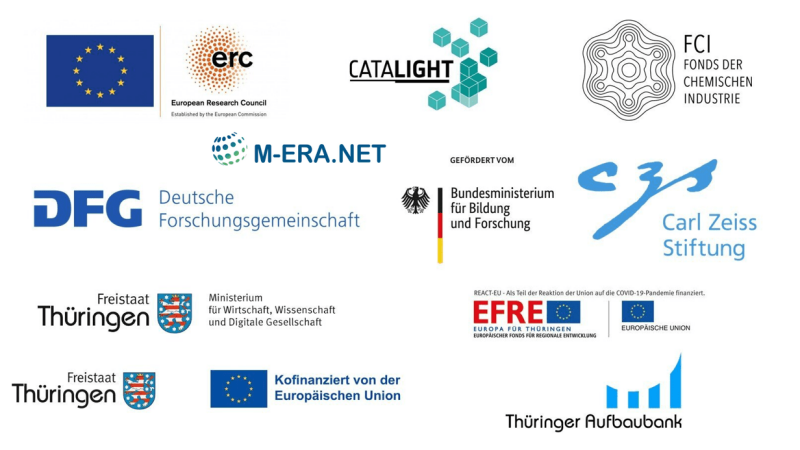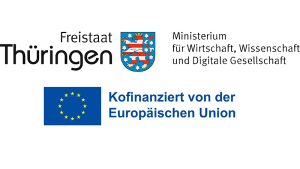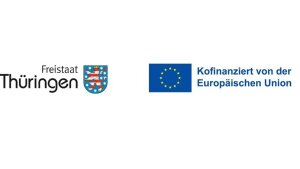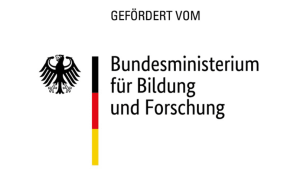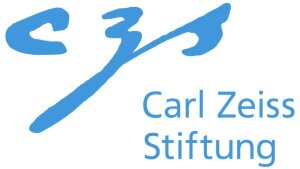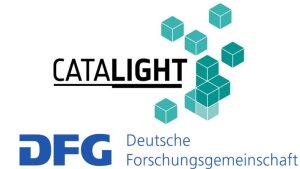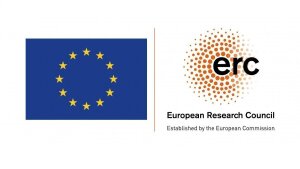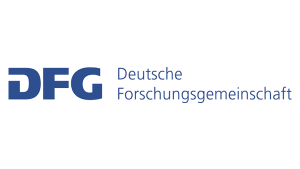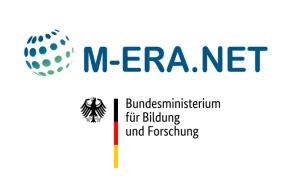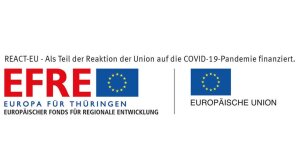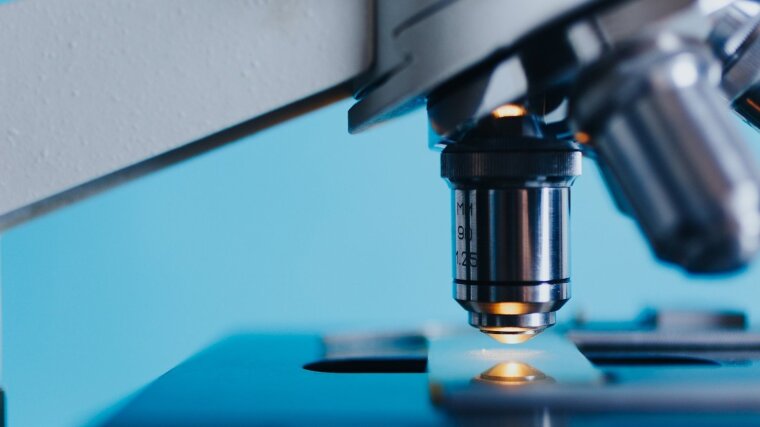
-
Richtlinie FTI-Thüringen PERSONEN: Research Unit ThüNaBsE – Thuringian Sodium Battery from for Scalable Energy Storage
Logo
Image: Erik TroschkeRichtlinie FTI-Thüringen PERSONEN: Research Unit ThüNaBsE – Thuringian Sodium Battery from for Scalable Energy Storage
Funding Agency
European Social Fund Plus (ESF+)/Thüringer AufbaubankResearch Topic and Project Partners
The motivation of the “Thuringian sodium battery for scalable energy storage” (“ThüNaBsE”) project is to build cross-location expertise for the development of future “sodium-ion batteries” along the entire value chain in Thuringia. In addition to building competence and intensifying cooperation between the institutions involved, the implementation of locally available raw materials in the production of sodium-ion batteries is a core goal of the project. In the joint project, AG Oschatz is mainly responsible for the chemical design of active materials of the positive and negative electrode, as well as for the electrochemical characterization and the investigation of structure-property relationships.ThüNaBsE is funded with ca. 1 000 000 EURO from the Federal State of Thuringia and from the European Social Fund Plus (ESF+) within the program ESF+ in Thuringia from 2024 to 2026. The Battery Innovation and Technology Center of the Fraunhofer Institute for Ceramic Technologies and Systems (Fraunhofer IKTS BITC) in Arnstadt acts as project coordinator. In addition to the AG Oschatz, Fraunhofer IKTS and the AG Dietzek-Ivanšić from the FSU Jena (Institute for Physical Chemistry) are involved in the project.
Project Duration
01/2024 – 12/2026
Project Volume
ca. 338 000 EURO (Funding of the Oschatz group)
-
Richtlinie FTI-Thüringen FORSCHUNG: Collaborative Laboratory DyNanoXRD – Characterization of Dynamic Processes and Structural Changes in Nanostructured Functional Materials with X-ray Powder Diffraction
Logo
Image: Erik TroschkeFunding Agency
European Social Fund/Free State of Thuringia/Thüringer AufbaubankResearch Topic and Project Partners
X-ray powder diffraction is a method for the structural characterization of crystalline or ordered materials. Such materials play a key role in electrochemical energy storage, catalysis and many other applications with relevance for energy and environment. Their structures do not only change during production, but also during use. The precise understanding of these changes is the basis for decoding the basic working mechanisms and thus offers the possibility of tailoring materials for a specific application in the future.With the construction of the DyNanoXRD network laboratory, a modern measurement infrastructure is being created that allows the formation and decay of crystalline phases in nanostructured functional materials to be examined during their production and under application conditions. The infrastructure measure initially focuses on the topics "carbon materials for energy applications", "electrochemical interfaces", "polymer materials" and "functional glasses". The funding is intended for the procurement and implementation of the measurement infrastructure. The joint project will investigate structural transformations and dynamic processes of nanomaterials under synthesis and application conditions in energy research and catalysis.
Six out of seven researchers involved in the project are scientific members of the CEEC Jena. The AG Oschatz acts as project coordinator. Further partners are the Schacher/Schubert groups (Institute of Organic Chemistry and Macromolecular Chemistry), the Turchanin group (Institute of Physical Chemistry), the Balducci group (Institute of Technical and Environmental Chemistry), and the Wondraczek/Brauer groups (Otto Schott Institute of Materials Research).
Project Duration
01/2023 – 12/2025
Project Volume
ca. 392 200 EURO
-
Richtlinie FTI-Thüringen PERSONEN: Research Unit DeKarbon – Selective Deposition and Chemical Conversion of Carbon Dioxide on Nanostructured Polymer Materials
DeKarbon
Image: Erik TroschkeFunding Agency
European Social Fund Plus (ESF+)/Thüringer AufbaubankResearch Topic and Project Partners
The implementation of processes for the separation, transport, and chemical upgrading of carbon dioxide based on energy from renewable sources is essential for the reduction of CO2 emissions in the future and to achieve negative emissions. The central aim of the research unit DeKarbon is the development of sustainable polymer materials with chemical structure motives that enable adsorptive separation of CO2, e.g, from flue gas or from air, at high selectivity and the coupling to catalytic conversion.DeKarbon receives funding of ca. 980.000 EURO from the Federal State of Thuringia and from the European Social Fund Plus (ESF+) within the program ESF+ in Thuringia from 2023 till 2025. All project partners are scientific members of the CEEC Jena. The Oschatz group acts as the project coordinator. Further partners are the Schubert group (Institute of Organic Chemistry and Macromolecular Chemistry), the Turchanin group (Institute of Physical Chemistry), and the Balducci group (Institute of Technical and Environmental Chemistry).
Project Duration
03/2022 – 12/2025
Project Volume
ca. 370.000 EURO (Funding of the Oschatz group)
-
„Joint project WaNaWa: Hydrogen storage in nano-water“ within the frame of the ideas competition: „Wasserstoffrepublik Deutschland“
Logo Federal Ministry of Education and Research
Image: BMBFFunding Agency
Federal Ministry of Education and Research (BMBF)Research Topic and Project Partners
The target of WaNaWa is to introducte a fundamentally novel physicochemical principle to store hydrogen close to room temperature. Currently, neither physical nor chemical hydrogen storage processes do promise a sufficiently high gravimetric and volumetric storage capacity close to room temperature at feasible pressures to store and release hydrogen. The reason behind is the weak bonding of hydrogen in physical processes, and the very strong bonding of hydrogen in chemical processes. The WaNaWa approach is to combine both storage principles in a synergistic way.The newly developed storage process relies on the formation of encapsulated gas clathrates as a result of the confinement of water within nanoporous carbon matrices. As known for many other gas encapsulation compounds, pores in the range of a few nanometers display special physicochemical conditions, which may allow for a rapid storage and release of guest molecules (e.g. H2) at moderate temperatures and pressures. This innovative approach will be investigated with regard to its scalability and technical feasibility right from the beginning. The project “WaNaWa” is funded by the Federal Ministry of Education and Research (BMBF) under the framework of the ideas competition “Wasserstoffrepublik Deutschland” since March 2024.
The project will be coordinated by Prof. Martin Oschatz (FSU Jena) and is mainly focussed on the synthesis of tailored carbon materials and their capability to store hydrogen. Moreover, Dr. Eva von Domaros (FSU Jena) will investigate the theoretical description of the intended hydrogen storage process. Also involved are researchers from Ruhr-Universität Bochum and Fraunhofer IKTS (Dresden). The Federal Ministry of Education and Research (BMBF) is funding the project with ca. 2.1 Mio €.
Project Duration
03/2024 – 02/2027
Project Volume
ca. 813 000 EURO (Funding of the Oschatz group)
-
Project „LignUp“ within the Programme „Breakthroughs“ of the Carl-Zeiss-Stiftung: Upgrading of Lignin for Fair Raw Materials
Logo Carl Zeiss Foundation
Image: Carl Zeiss StiftungFunding Agency
Carl-Zeiss-FoundationResearch Topic
The joint procject “LignUp” has the ambitious target of upgrading lignin, which is currently considered as waste, to a valuable feedstock compound. Lignin is a biopolymer, being produced within the cells of perennial plants and basically serves to lignify the latter. In the pulp industry, lignin is currently separated and is seen as a biogenic waste product which is mostly burnt. However, the molecular building blocks of lignin can have a high value. Moreover, ways of segregating lignin into smaller molecules are already known. LignUp will focus on a materials library and the development of synthetic ways to produce tailored (organic, inorganic, hybrid) functional materials based on depolymerized lignin fragments. Additionally, these materials will be investigated towards their applicability in fields such as energy storage or the recycling of precious metals from waste water. It is the ultimate goal to switch the role of lignin from a waste product to a valuable and reusable material. The consortium combines partners from FSU Jena, the University of Bayreuth and the Thuringian Innovation Centre for Reusable Materials (ThiWert) and thus offers complementary expertises ranging from energy materials, polymer chemistry, electrochemistry, spectroscopy, water treatment, surface and interface characterization, theoretical chemistry, life cycle analysis, recycling technology to environmental politics.LignUp will be funded with ca. 5 000 000 € over 6 years and is designed to allow for the formation of long-lasting expertise and infrastructure at the FSU Jena. The project will be coordinated by Prof. Dr. Martin Oschatz and Prof. Dr. Michael Stelter (both FSU Jena) from the Institute of Technical and Environmental Chemistry. In summary, 9 PIs from FSU Jena will collaborate and support the undertaking.
About the Carl-Zeiss-Stiftung
The Carl-Zeiss-Foundation’s mission is to create an open environment for scientific breakthroughs. As a partner of excellence in science, it supports basic research as well as applied sciences in the STEM subject areas (science, technology, engineering and mathematics). Founded in 1889 by the physicist and mathematician Ernst Abbe, the Carl-Zeiss-Stiftung is one of the oldest and biggest private science funding institutions in Germany. It is the sole owner of Carl Zeiss AG and SCHOTT AG. Its projects are financed from the dividend distributions of the two foundation companies.
Within the framework of the ‘CZS Breakthroughs’ programme, the Carl Zeiss Foundation funds top international research from Baden-Württemberg, Rhineland-Palatinate and Thuringia. The goal is to help universities advance and expand their identified research strengths (inter)nationally. A prerequisite for funding by the Carl Zeiss Foundation is national expertise in the respective field of research. The funded research area must be structurally sound and highly relevant to the strategic orientation of the higher education institution.
Project Duration
10/2024 – 09/2030
Project Volume
ca. 5 000 000 EURO (all PIs)
-
Battery 2020 Transfer Project „Natter“: Optimised solid-state Sodium batteries with novel anodes based on carbon frameworks
Logo Federal Ministry of Education and Research
Image: BMBFFunding Agency
Federal Ministry of Education and Research (BMBF)Research Topic and Project Partners
Sodium-ion batteries (SIBs) with liquid electrolytes are currently intensely investigated as they are discussed as cheap alternatives for stationary as well as mobile applications. In this project, the utilization of solid-state electrolytes with a high conductivity for sodium ions as well as carbonaceus frameworks shall lead to a transformation towards safer all-solid-state sodium batteries (SSSB).The “Natter” project is funded since February 2023 by the Federal Ministry of Education and Research (BMBF) within the project line “Batterie 2020 Transfer”. The overall target is the investigation and evaluation of SSSB which will be composed of carbon/solid-electrolyte composites, sulfidic separators and cobalt-free cathode materials.
The project will be coordinated by Prof. Jürgen Janek (JLU Gießen) and is mainly focussed on the optimisation of novel anodes based on carbonaceous framework structures – but is also considering the other cell components. In addition to the team of JLU Gießen, also researchers from Münster (Westfälische Wilhelms-Universität Münster), Berlin (Humboldt‑Universität zu Berlin and Helmholtz‑Zentrum Berlin), Jena (Oschatz group) as well as an industrial representative (Heraeus Kohlenstoff Technology) are part of the consortium. Next to academic members, further industrial partners such as BASF SE, EL-Cell GmbH, Orion Engineered Carbons, rhd instruments GmbH, and Blackstone Technology GmbH belong to the overall council. The Federal Ministry of Education and Research (BMBF) is funding the project with ca. 2 Mio €.
Project Duration
02/2023 – 01/2026
Project Volume
ca. 347 000 EURO (Funding of the Oschatz group)
-
CRR/TRR 234 CataLight, Project B10: Modulating the Photocatalytic Properties of Molecularly Functionalized Carbon Nitride Polymers by Nanoconfinement and Pore Structure Engineering
CataLight
Image: Erik TroschkeFunding Agency
German Research Foundation (DFG, Deutsche Forschungsgemeinschaft)Research Topic and Project Partners
The joint transregional Collaborative Research Center "Light-driven Molecular Catalysts in Hierarchically Structured Materials - Synthesis and Mechanistic Studies" („CataLight“) of the University of Ulm and the Friedrich-Schiller-University Jena investigates the basic functionality as well as first applications of innovative photocatalytically active materials. The CRC/TRR CataLight addresses fundamental challenges in the design of photocatalytically active materials for solar energy conversion. Inspired by the design principles of natural photosynthesis in green plants. Within project B10 molecular catalysts are embedded in carbon nitride matrices and their structure-properties in light-driven processes are investigated in strong collaboration with theory and spectroscopy. The project is carried out in collaboration with the research group of Timo Jacob (Ulm University).Project Duration
07/2022 – 06/2026
Project Volume
ca. 165.000 EURO (Funding of the Oschatz group)
-
ERC Starting Grant "CILCat": Nanocarbon-Ionic Liquid-Interfaces for Catalytic Activation of Nitrogen
ERC Logo
Image: EUFunding Agency
European Research Council
Research Topic and Project Partners
The synthesis of ammonia, one of the most important commodity chemicals is currently carried out by the Haber-Bosch-process, causing approx. 1-2 % of the global carbon dioxide emissions and consuming as much energy. The target of CILCat is therefore, to explore alternative approaches towards the electrochemical generation of ammonia using nitrogen, water, and electricity from renewable sources. Here, room-temperature ionic liquids confined in nanoporous carbons are used to create tailored catalytical nanoenvironments to activate the inert nitrogen molecules, enabling an efficient ammonia synthesis.
CILCat receives a funding of ca. 1.5 Mio € over a period of five years from the European Research Council via an ERC starting grant. The project encompasses funding for two post-doctoral researchers and four PhD students. Prof. Oschatz acts as the project coordinator and is situated at the Institute of Technical and Environmental Chemistry of FSU Jena.
Project Duration
10/2022 – 09/2027
Project Volume
ca. 1 500 000 EURO
-
NSERC-DFG SUSTAIN Project „OILSANDSBATT“: Carbon Materials from Oil Sands-derived Asphaltenes for next Generation Sodium-Ion Batteries – from Mechanistic Investigations to Life Cycle Analysis
DFG Logo
Image: DFGNSERC-DFG SUSTAIN Project „OILSANDBATT“: Carbon Materials from Oil Sands-derived Asphaltenes for next Generation Sodium-Ion Batteries – from Mechanistic Investigations to Life Cycle Analysis
Funding Agency
German Research Foundation (DFG, Deutsche Forschungsgemeinschaft)Research Topic and Project Partners
Lithium-ion batteries (LIBs) are the currently established electrochemical energy storage devices in fields where high energy density is a strong requirement. It is expected that the current annual demand for lithium will increase by a factor of 18-20 until 2050, driven by the increasing demand for automotive lithium-based batteries. The limited availability of lithium and the environmental issues associated with its extraction are the main driving forces for research on alternative battery systems such as sodium-ion batteries (SIBs). The commercialization of SIBs is in progress, however, the SIB technology, which uses mainly soft- and hard carbons fabricated from expensive natural precursors as anode material, still suffers from lower specific gravimetric energies than graphite-based LIB systems. As one of the largest LIB producer world-wide, there is a special interest for the German economy to also take part in the commercialization of environmentally friendlier battery systems such as SIBs. One major aspect for the commercialization of a battery product, besides high specific capacity and stability, is its price. It is crucial to use starting materials with a low cost. A potential abundantly available and low-cost anode precursor are so-called asphaltenes. In Alberta, Canada, thousands of tons of asphaltenes are produced daily, as a byproduct of oil sands processing. Technically, they are defined as the crude fraction, which precipitates upon the addition of an excess of n-heptane, but are soluble in toluene. Asphaltenes are currently applied as paving materials, waterproof coatings on building foundations. However, their present applications do not generate the need even close to the amount generated. Therefore, asphaltenes are often simply combusted. Consequently, there is a big interest of Canadian researchers to upcycle such asphaltenes and to thereby extend their life-cycle. OILSANDSBATT will combine these two aims together into one collaborative work between German battery and Canadian material engineering experts. The idea behind the project is to generate a unique synergy between two research foci of Canada and Germany, namely the value-adding upgrade of the waste product asphaltenes and the development of electrode materials for future battery systems, respectively. OILSANDSBATT will focus on the development of next-generation SIBs, which will use oil sands-derived asphaltenes for the fabrication of anode materials. The main scientificobjectives within the planned project are i) the establishment of asphaltenes-derived carbon fibers and carbon modified carbon fibers as anode materials in SIB, ii) to investigate underlying storage mechanisms to enable targeted optimization of the cells towards high energy density and lifetime, and iii) the estimation of the product’s CO2 emissions based on an LCA analysis, which will built on the data from the synthetically and electrochemically oriented work packages.
The project consortium consists of 4 research groups based in Canada and Germany. Prof. Weixing Chen (University of Alberta) and Prof. Amit Kumar (same affiliation) are experts in chemical engineering and mechanical engineering. They are complemented by Prof. Jan Philipp Hofmann (TU Darmstadt), who is an expert in spectroscopic characterization, and AG Oschatz (FSU Jena), who will be responsible for the electrochemical characterization of the materials.
Project Duration
03/2024 – 02/2027
Project Volume
ca. 268 000 EURO
-
M-ERA.NET Projekt "CoLi-SCo": Multiscale Coupling of Lithium-Sulphur Battery Compounds from Carbon Pores to Full Cell
Learn moreExternal linkdeM-Era-NET-BMBF
Image: M-Era-NET und BMBFFunding Agency
Bundesministerium für Bildung und Forschung (BMBF) - within the frame of M-ERA.NET III
Research Topic and Project Partners
The targets of the European Green Deal can only be reached if batteries with high specific energy and long lifetime based on abundant sources are brought to
market. One promising candidate are lithium-sulphur batteries which were investigated on lab scale in recent years but broad implementation is still not achieved. The Major aim of CoLi-SCo is to support the practical implementation of Li-S batteries. It combines partners covering a range of different expertise, from fundamental research to industrial materials production. The batteries developed will be applicable in various applications such as mobile/stationary energy storage or electric mobility. CoLi-SCo follows a holistic approach and goes beyond investigation of structure-property relationships. Understanding for the interplay of different components in practically relevant lithium-sulphur cells will accelerate implementation of this technology which can positively impact the future quality of life.Besides the Friedrich-Schiller-Universität, Helmholtz-Zentrum Berlin für Materialien und Energie GmbH (HZB), the Orion Engineered Carbons GmbH, the Poznan University of Technology (Poland), the Agencia Estatal Consejo Superior de Investigaciones Científicas (Spain), the Lukasiewicz Research Network (Poland), as well as the INNOVATOR Sp.z.o.o. (Poland) are partners within the project.
Project Duration
10/2024 – 09/2027
Project Volume
ca. 417 000 EURO (funded part of AG Oschatz)
-
FOR-Richtlinie: Collaborative Laboratory NanoLabXPS - X-ray Photoelectron Spectroscopy for the Development of Nanomaterials with Tailored Interfaces for Energy Storage and Catalysis
EFRE
Image: Erik TroschkeFunding Agency
European Regional Development Fund (ERDF)/Thüringer AufbaubankResearch Topic and Project Partners
X-ray photoelectron spectroscopy (XPS) is a method for the analysis of the chemical composition and chemical bonding motives on the surface of nanomaterials and at their interfaces with other materials. With the collaborative research laboratory NanoLabXPS the interdisciplinary research area “XPS for the development of nanomaterials with tailored interfaces with energy applications and catalysis” will be established at the Center for Energy and Environmental Chemistry Jena (CEEC Jena). Within the collaborative project, interface phenomena at nanomaterials and nanohybrids in energy research and catalysis will be investigated.8 out of 9 project partners are scientific members of the CEEC Jena. The Oschatz group acts as the project coordinator. Further partners are the Schacher/Schubert groups (Institute of Organic Chemistry and Macromolecular Chemistry), the Turchanin/Dietzek groups (Institute of Physical Chemistry), the Wächtler group (Leibniz Institute for Photonic Technology), the Balducci group (Institute of Technical and Environmental Chemistry), and the Wondraczek group (Otto Schott Institute of Materials Research).
Project Duration
09/2021 – 04/2023
Project Volume
ca. 471.000 EURO
